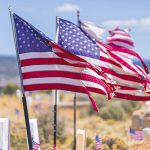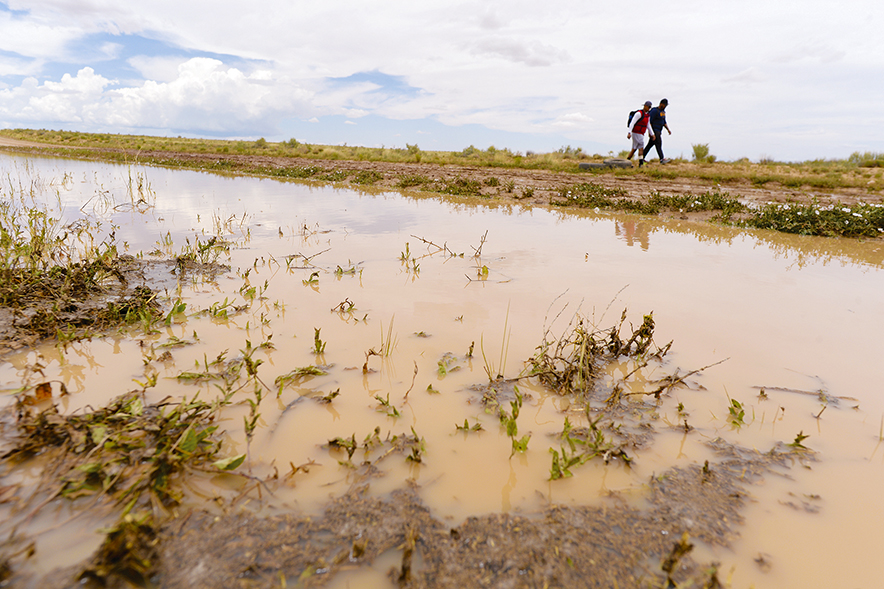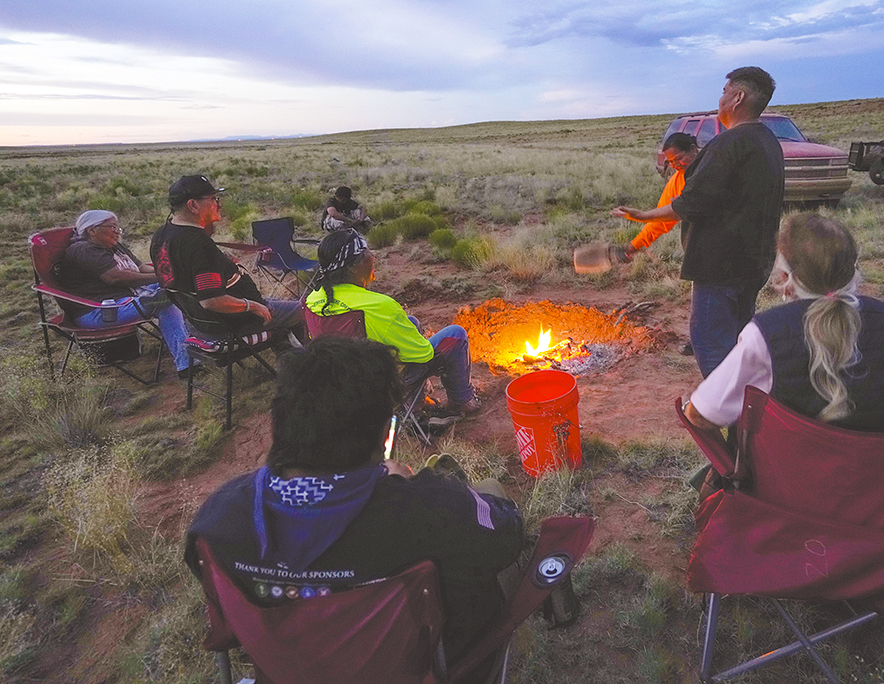
Indigenous men walk for sobriety and mental health

Special to the Times | Donovan Quintero
As part of the treatment program, Beacon Treatment Center clients walk along Navajo Route 25, a dirt road connecting Cottonwood, Ariz.
By Donovan Quintero
Special to the Times
BURNSIDE, Ariz. – On a cloudy Saturday morning, with temperatures at 77 degrees, a group of men embarked on a journey toward sobriety and mental wellness. The recent monsoons have refreshed the landscape, creating a serene atmosphere for this introspective walk.
The previous evening, they observed a spectacular display of the lightning deity’s might as thunder roared and winds fiercely battered their tents. In a mix of wonder and determination, they marveled at the raw power while striving to secure their tents from imminent collapse.
The men, scattered along a lengthy dirt road that seems to stretch endlessly, are deep in thought as they traverse this path of recovery. Some walk in solitude, while others form supportive groups.
For most of the 11 men, their journey to a sober life has just begun. The program, provided by Beacon Treatment Center in Vernon, Arizona, is part of their path to sobriety.
Walking the sober path, relapse rates
Myron Eriacho, one of the treatment center’s outreach specialists and traditional counselors, who is also walking the sober path, walked with the men.

Special to the Times | Donovan Quintero
A client of Beacon Treatment Center is given a blessing after completing a 17-mile walk as part of his treatment program on Saturday evening in Burnside, Ariz.
“Our relationship with the guys is really to provide that guidance or direction, as some of us have gone to treatment ourselves,” he said on Saturday. “So, when I’m with the guys, it reminds me of when I was at treatment. I’ve been to the treatment center two times in my life before I sobered up, and so all of us are in recovery, and that’s a good thing.
Eriacho commended the men for their hard efforts to understand their addictions. But from his personal experiences, staying sober versus wanting to be sober are two very different ways of living.
“Not all of the guys that come to Beacon — we know that there’s a percentage that will stay clean and sober — but the reality of it is that some of them will back out,” he said. “That’s really up to them.”
Recidivism rates for Native American men are astoundingly high, according to the Indian Health Service. Alcohol, substance use, mental health disorders, suicide, violence, and behavior-related morbidity and mortality rates in Indigenous communities far exceed the national average. Studies show disproportionately high rates of mental health issues like suicide, violence, and substance abuse among Indigenous populations. This disparity leads to significantly more psychological distress reported by Indigenous individuals—2.5 times higher than the general population within a month.
Indigenous communities have the highest rates of suicide among any minority group in the U.S., with rates on the rise since 2003, IHS cites. Additionally, they experience high rates of substance use disorder involving both illicit drugs and alcohol. Between 2016 and 2020, they faced significantly higher rates of alcohol-related deaths — 519 per 100,000 — compared to the rest of the U.S. population — 12 per 100,000.
Already facing health inequities in their communities, Eriacho said the men face another stark reality of returning to their homes with no solid foundation of support they will need from families, friends, and their communities.
Eriacho added the treatment center has a transition program they offer their clients that can help them from relapsing.
“We have some guys that have gone to transitional living and who completed the program,” he said, adding the program has some success stories. “We got some Navajo tribal members and members from other tribes or ethnic backgrounds who went into the after-treatment program and now they’re working.”
Walking in moccasins, contemplating the future, healing
Myron Eriacho walks in his moccasins. Traces of dried mud can be seen scraped onto the leather. He participates and says he sees the walk as a pivotal moment for the men, as each seems to reflect on their past struggles and contemplate a brighter future. From his perspective, he hopes they carry their newfound strength back to their communities, hopefully breaking the cycle of addiction while inspiring the younger generations to follow a different path.

Special to the Times | Donovan Quintero
A walker walks to meet clients from Beacon Treatment Center on Saturday as they do a 17-mile walk on Navajo Route 25, which connects to Cottonwood, Ariz.
“We have some guys who are building houses now in Show Low. They choose not to go back home; they’d rather learn a trade. Like for example, we have a couple of young guys who went to work with an older guy who is a carpenter. They build houses now. They’re working for a contractor in Show Low. So, they’re staying clean and sober,” Eriacho said.
Nolan, 53, who only gave his first name due to the treatment center’s confidentiality policy, said he was told once by a doctor that binge drinkers die violently and alone.
He explained he was staying at a sober living home for meth addiction in Phoenix when he decided it was not working for him.
“I was in a sober living home for a while, but it wasn’t that productive for me. So I left to catch the bus back to Gallup,” Nolan said. “But before I did that, I bought two bottles of liquor, drinking, blacked out, and I was almost run over by a city bus.”
When he returned to the reservation, he couldn’t believe he was almost killed by a bus because of his drinking.
When he sought help at Sage Memorial Hospital, a PL 93-638 health facility, in Ganado, he was told by a social worker and an emergency doctor, who painted a stark reality into his mind.
“A doctor told me one time, ‘Yeah, you’re a binge drinker. Binge drinkers die alone. They die violently. They’re hit by cars, they’re murdered.’ And when he told me that, I thought to myself, ‘That would never happen to me. Never, I’m too careful.’ And yet, it almost happened to me. I said, ‘I need to get my life under control,’” Nolan said after completing his 17-mile journey. “So, I came back up here to the reservation, healed up.”
When he decided to leave the sober living home, the 90-day program had stretched into nine months. Nevertheless, he said he felt confident enough to begin a meth-free life. Then alcohol came into his life.
“I felt confident enough to come out here again and not use, but I replaced that with alcohol, and it nearly cost me my life,” Nolan said. So I told myself, ‘I need to do something. If I wanted to continue to live.’ I don’t want to be a statistic, so that’s why I’m at Beacon for alcohol.”
Read the full article in the June 27, edition of the Navajo Times.








 Highway 264,
Highway 264, I-40, WB @ Winslow
I-40, WB @ Winslow